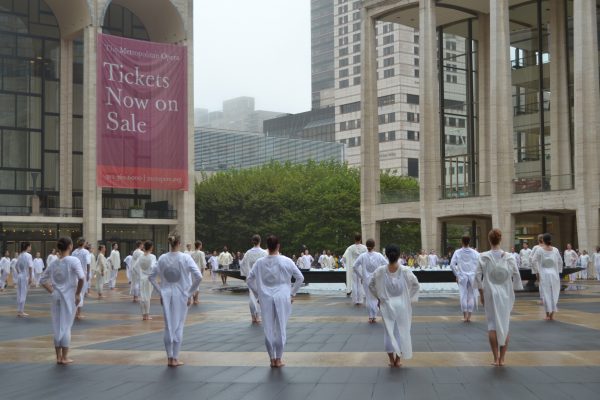Dancers Bring NYC to a Pause on 9/11
COURTESY OF ELIZABETH KANG
Table of Silence, which was launched in 2011, features both professional dancers and Fordham/Ailey BFA students.
September 26, 2018
Pedestrians from all over New York City gathered around the Josie Robertson Plaza at Lincoln Center on Sept. 11, quietly awaiting the annual Table of Silence performance. Then suddenly, the musicians played a mournful tune through conch shells. 167 dancers, draped beautifully in white clothe, hurried to the center of the plaza and hit a grief-stricken pose. Once all of the dancers were visible to the audience, they continued moving about with the music. Each one moved freely about the plaza to their own rhythms, each telling their own story. The audience felt the pain that the dancers expressed. They felt the sadness and fear surrounding the attacks that took place 17 years ago. There was a pause in the chaos as the dancers created a unified circle, evoking a sense of peace that reverberated through the audience.
The Table of Silence Project is a meditative form of prayer presented by dedicated musicians and dancers. The project began in September 2011 with the ultimate goal of promoting universal peace for all those affected by the tragic day in history. The movement serves as a reminder to all that even in these most painful moments, we have the ability to come together as a community and to help lift each other up, whether that means sitting together in silence, or expressing ourselves through art and movement.
Everyone was affected differently by 9/11 and has different ways of combating their emotions about the event. Meagan King, Fordham College at Lincoln Center (FCLC) ’20 and Ailey/Fordham B.F.A. student, decided to participate in this year’s performance as a way to remember her uncle, who was the captain of an NYC police force and first responder during 9/11 and the days thereafter. King lost her uncle 10 years later due to lung cancer, which was a direct result of the toxins he was exposed to from the fallout of the towers. The performance, she said, was a peaceful outlet for her to pay respects to her beloved uncle.
The art of expression is certainly not lacking in New York, but one thing that makes the project so unique is that it captures so many different forms of art in one performance. Featuring dancers from numerous dance studios, conch players, flute players and vocalists, the project exhibits the arts at its finest. It is important for individuals to express themselves in times of fear and pain, and many people believe dance is one way to do so. “When we give ourselves over completely to the spirit of the dance, it becomes a prayer,” Gabrielle Roth, the late American dancer and musician, said. Artists oftentimes use their compositions to express their thoughts and feelings that cannot be put into words. This is what makes the craft so compelling.
Dancers perform at Lincoln Center in honor of those lost on 9/11.

King’s favorite part of the performance was the simple gestures that the dancers make repeatedly throughout the duration. Dancers shook their hands close to their head, held their arms up, dropped their heads down, contorted their bodies and hit their hands together. Though the movements of each dancer varied, they represented the unity of all people in that everyone moved to the same rhythm and everyone, in this point of the dance, moves in the same direction. Some of the movements also symbolized the twisted bodies found during 9/11 and the panicked hearts of numerous individuals from the trauma. A Tibetan singing bowl helps to cultivate the soothing energy needed to combat all of the pain released in the performance.
Jacqulyn Buglisi, director and choreographer of Table of Silence Project, is also on faculty at the Ailey School. She encouraged Ailey Professional Division students to get involved with the project throughout her years with Fordham. Though people from the public have to audition for the performance, Ailey Professional Division students are accepted to participate without auditioning.
Around 20 Ailey students out of the total 167 dancers participated this year, though King hopes more will take advantage of the opportunity in the future. “Once you participate in an event like this, you put something within yourself that you can never put back,” she said. “I want to communicate this feeling with audiences worldwide because the impact of art is crucial to shaping the world around us. It takes one spark to ignite the wild flames of a fire.”
Buglisi’s dancers look up to her not only for her dedication to dance, but also for her dedication in promoting well-being and love for all people. “Buglisi is not just a teacher but a person,” King said. This performance is a way to honor her and all that she does.
There are so many compelling ways within art to tell stories. Through dance, dancers in the Table of Silence Project model the traumatic impact of Sept. 11 on various individuals. From their story, the dancers convey the fact that no one in these circumstances ought to suffer alone. We all struggle in these times of despair, but with the power of movement, meditation and prayer, we will come together, and we will rise.













